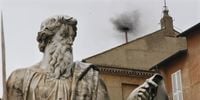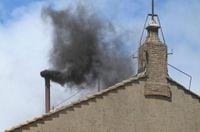As the world watches the Vatican, the ongoing conclave has yet to yield a new pope, with the black smoke signal emerging from the chimney of the Sistine Chapel at 11:51 AM on May 8, 2025. This year, 133 cardinals have gathered to choose the successor to Pope Francis, who passed away recently, marking the end of an era and the beginning of a new chapter for the Catholic Church.
The anticipation surrounding this conclave is palpable, as millions await the announcement of the next leader of the Catholic Church. The black smoke, a traditional indicator that no decision has yet been made, billowed out in front of approximately 15,000 onlookers in St. Peter's Square, who captured the moment with their smartphones while news cameras broadcast the event worldwide.
The conclave process itself is steeped in history and ritual. The term "conclave" derives from the Latin phrase "cum clave," meaning "with a key," signifying the seclusion of the cardinals in the Sistine Chapel. The current rules governing the conclave, established by Pope John Paul II in his apostolic constitution, Universi Dominici Gregis, dictate that the cardinals must remain locked in until a new pope is elected, with stringent measures in place to ensure secrecy, including the disabling of communication devices.
In this conclave, the cardinals will cast their votes multiple times a day, with the first day allowing only one ballot, and subsequent days permitting up to four. If no pope is elected, the ballots are burned, producing the iconic black smoke. However, if the cardinals reach a consensus, white smoke will signal the news of the new pope's election, followed by the ringing of church bells.
The significance of the smoke signals cannot be overstated. The first documented instance of smoke being used to indicate a papal election dates back to 1878 during the election of Pope Leo XIII. However, the clear distinction between black and white smoke as we understand it today was not established until 1914 with the election of Pope Benedict XV. This year’s conclave has already seen its first black smoke, a reminder of the uncertainty that surrounds the election process.
As the cardinals gather for prayer and reflection, they also face the weight of ancient prophecies that have resurfaced in the wake of Pope Francis's death. One of the most famous is attributed to Saint Malachy, an Irish bishop who is said to have predicted the identities of the popes from Celestine II onward. According to this prophecy, Pope Francis is the last pope, referred to as Petrus Romanus, which has sparked speculation and concern among the faithful.
Another prophecy that has gained traction is that of the "black pope," a term used to describe a Jesuit pope. With Pope Francis being the first Jesuit pope, some believe he may fit this description, leading to theories about the implications of his papacy and what it means for the future of the Church.
In the context of these prophecies, Cardinal Peter Kodwo Appiah Turkson has emerged as a notable candidate for the papacy. Born on October 11, 1948, in Wassaw Nsuta, Ghana, Turkson was ordained a priest in 1975 and studied theology in New York and Rome, specializing in Sacred Scripture at the Pontifical Biblical Institute. He served as Archbishop of Cape Coast and was created a cardinal in 2003. Notably, Turkson has been a champion for the marginalized, addressing issues such as poverty, migration, and human rights during his tenure as the first prefect of the Dicastery for Promoting Integral Human Development, established by Pope Francis in 2016.
His candidacy represents a potential shift in the papacy, as he would be the first Black pope, a significant milestone for the global Church. His blend of progressive social views and conservative theological positions positions him as a bridge between tradition and contemporary challenges.
As the conclave unfolds, the world remains captivated by the rituals and the potential for change within the Catholic Church. The black smoke serves as a reminder of the ongoing deliberations among the cardinals, who are tasked with not only selecting a new leader but also navigating the complex legacy left by Pope Francis.
The conclave opened on May 7, 2025, and as the cardinals engage in prayer and discussion, they will also partake in Mass and Lauds, reinforcing the spiritual significance of their mission. The future of the Catholic Church hangs in the balance, with many hoping for a leader who can guide the faithful through the challenges of modern society while remaining true to the Church's foundational teachings.
The next smoke signal will be closely monitored, as it will determine whether the cardinals have reached a decision or if further deliberation is needed. The world watches as the age-old ritual of the conclave continues, blending tradition with the immediacy of modern media coverage.
In the end, the choice of the new pope will be more than just a name; it will symbolize the direction the Catholic Church intends to take in addressing contemporary issues while embracing its rich history. The anticipation builds as the cardinals prepare for their next round of voting, hoping to bring clarity to a moment that has captured the attention of millions.


